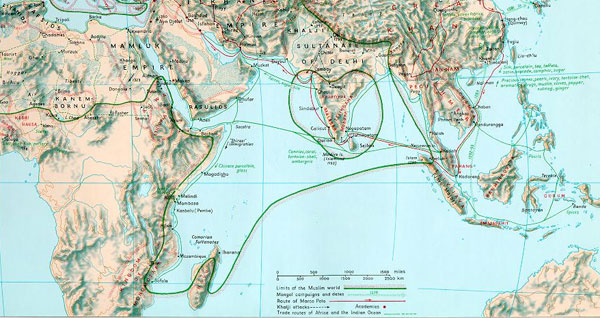مطالعات خلیج فارس
ایران را بشناسید تا ایران را بیشتر دوست بداریدمطالعات خلیج فارس
ایران را بشناسید تا ایران را بیشتر دوست بداریدold sea routes
 The
Sea Route, showing how the trade of goods extended from China's Han
Dynasty through the old spice routes and the Straits of Malacca, around
Sri Lanka and Western India, both delivering and collecting cargo, then
across the Arabian sea to the Middle East and East Africa. Java,
Sumatra, Malaysia and the ancient Khmer, Thai, Lao Viet and Burmese
civilizations all grew wealthy from the Sino-Indian and were settled by
Indian and Chinese merchants
The
Sea Route, showing how the trade of goods extended from China's Han
Dynasty through the old spice routes and the Straits of Malacca, around
Sri Lanka and Western India, both delivering and collecting cargo, then
across the Arabian sea to the Middle East and East Africa. Java,
Sumatra, Malaysia and the ancient Khmer, Thai, Lao Viet and Burmese
civilizations all grew wealthy from the Sino-Indian and were settled by
Indian and Chinese merchants

Map of The Silk Road, The Spice Route & Incense Trail
The History of Incense and Spices
 The
development of incense and spices has a long history, with their
earliest use found in the Mesopotamian Civilization several thousand
years ago. According to ancient documentation, as much as 2.5 tonnes of
frankincense were burnt in the Temple of Baal in Babylon each year;1
and there were inscriptions about incense offerings for gods on the
clay tablets of The Epic of Gilgamesh, “the world's oldest literature”.2
In the Book of Exodus of the Old Testament, there are verses describing
the Lord teaching His people how to make the holy anointing oil and
incense:
The
development of incense and spices has a long history, with their
earliest use found in the Mesopotamian Civilization several thousand
years ago. According to ancient documentation, as much as 2.5 tonnes of
frankincense were burnt in the Temple of Baal in Babylon each year;1
and there were inscriptions about incense offerings for gods on the
clay tablets of The Epic of Gilgamesh, “the world's oldest literature”.2
In the Book of Exodus of the Old Testament, there are verses describing
the Lord teaching His people how to make the holy anointing oil and
incense:
“Moreover the LORD spake unto Moses, saying, Take thou also unto thee principal spices…And thou shalt make it an oil of holy ointment, an ointment compound after the art of the apothecary: it shall be an holy anointing oil. And thou shalt anoint the tabernacle of the congregation therewith, and the ark of the testimony…And thou shalt sanctify them, that they may be most holy…And thou shalt speak unto the children of Israel, saying, this shall be an holy anointing oil unto me throughout your generations… And the LORD said unto Moses, Take unto thee sweet spices…these sweet spices with pure frankincense: of each shall there be a like weight: And thou shalt make it a perfume, a confection after the art of the apothecary, tempered together, pure and holy…it shall be unto you most holy...it shall be unto thee holy for the LORD...Whosoever shall make like unto that, to smell thereto, shall even be cut off from his people.”
(Exodus, Chapter 30, verses 22-38) 3
 Moreover,
archaeologists discovered pellets of frankincense in the tomb of the
Egyptian Pharaoh Tutankhamun (1341 – 1323 BC). A wall inscription in
Karnak also details the incense offering rituals of Pharaoh Rameses II
before a sacred barge around 1224 BC.1 In fact, incense
culture can be found among different races, including the Phoenicians,
the Arabs, the Indians as well as the Greeks and Romans.4
Moreover,
archaeologists discovered pellets of frankincense in the tomb of the
Egyptian Pharaoh Tutankhamun (1341 – 1323 BC). A wall inscription in
Karnak also details the incense offering rituals of Pharaoh Rameses II
before a sacred barge around 1224 BC.1 In fact, incense
culture can be found among different races, including the Phoenicians,
the Arabs, the Indians as well as the Greeks and Romans.4


























